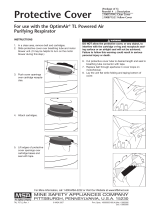3M™ Replacement Parts and Accessories
(Fig. 2)
Part Number Description
[1] 060-46-34R01 Headgear Shell, White
(for AS-400LBC and
AS-600LBC)
[-] 520-01-86R01 Headgear Shell
Assembly, White, with
Visor Surround, (for
AS-400LBC)
[-] AS-650 Headgear Shell
Assembly, with
Bracket and Hinge (for
AS-600LBC)
[2] AS-140-5 High Efficiency Filter
(5/pack)
[2] AS-140-25 High Efficiency Filter
(25/pack)
[2] AS-176 Hydrogen Fluoride
Cartridge
2
(25/pack)
[3] AS-120-10 Prefilter (10/pack)
[4] AS-110-2 Filter/cartridge holder
(2/pack)
[5] 060-39-01R10 Comfort Band (10/pack)
[6] AS-150 Cradle Assembly
[7] 060-38-05R01 Headband
[8] 060-28-03R01 Head Seal
[9] 060-19-00R01 Prefilter Inner Grill
[10] 060-20-00R01 Prefilter Outer Grill
[11] 060-04-03R01 Motor Housing Assembly
[11] AS-115 Motor Housing Assembly,
Ultra (for AS-400LBC and
AS-600LBC)
[-] 520-01-81 Carrying Bag
[-] 520-01-02R01 Battery Pack, Intrinsically
Safe (for AS-400LBC and
AS-600LBC)
[-] 520-01-82 Clothing Clip and Screw
(for Battery)
[12] 061-37-00R02 Pivot and Cams, pair
[13] 060-49-02R10 Temple Seal (10/pack)
[14] 522-01-01R10 Visor (10/pack)
[14] 060-75-02R10 Visor, Gray Tinted
(10/pack)
[14] AS-131-10 Visor, Antifog, Scratch
Resistant (10/pack)
Part Number Description
[-] 529-02-37R10 Protective Overlay
(10/pack)
[15] AS-170 Visor Surround
Assembly, without
Lamp Bracket and
Hinge (for AS-400LBC)
[15] AS-170M Visor Surround
Assembly, with Lamp
Bracket and Hinge (for
AS-600LBC)
[16] 520-01-62 Mining Lamp Bracket
and Hinge (for AS-
600LBC)
[-] 1455 Headgear-Mounted
Ear Muff Kit (NRR 23/
CSA Class B)
[-] 527-01-15R10 Faceseal, Tychem®
QC (10/pack)
[-] AS-101-10 Faceseal, Elastomeric
(Small/Medium)
1
[-] AS-102-10 Faceseal, Elastomeric
(Medium/Large)
1
[-] 529-01-09R01 Chin Strap
[-] 529-01-59R01 Clip (for Mining Lamp
Cord)
[-] 529-01-56R01 Battery Cover, Water
Repellent
[-] 520-03-73 Smart Battery Charger,
Single Unit
[-] 520-01-61SGL Smart Battery Charger,
Single Unit (Canada
only)
[-] 520-03-72 Smart Battery Charger,
5 Unit
[-] 520-01-61FIV Smart Battery Charger,
5 Unit (Canada only)
[-] 520-01-61 Smart Battery Charger,
10 Unit
[-] 061-44-01R01 Airflow Indicator
Notes:
1
The 3M™ Faceseals, AS-101-10 and AS-102-10, are approved for use with 3M™ Headgear-
Mounted Assemblies AS-400LBC and AS-600LBC equipped with the motor housing assembly
AS-115. The faceseals, AS-101-10 and AS-102-10, are NOT approved for use with the 3M™
Battery Pack 520-01-18R01 or the 3M™ Standard Motor Assembly 060-04-03R01.
2
The 3M™ Hydrogen Fluoride Cartridge AS-176 is approved for use only with the headgear-
mounted assembly AS-400LBC equipped with the motor housing assembly AS-115, ultra. The
hydrogen fluoride cartridges AS-176 are NOT approved for use with the 3M™ Battery Pack
520-01-18R01 or the 3M™ Standard Motor Assembly 060-04-03R01. The AS-176 is not NIOSH
approved for particulates.
Service Life of Chemical Cartridges and Filters
The useful service life of the 3M™ Hydrogen Fluoride Cartridges AS-176 will depend upon the flow
rate, the specific type, volatility and concentration of the contaminants and environmental conditions
such as humidity and temperature. Replace cartridges in accordance with an established cartridge
change schedule or time-use restrictions, whichever occurs first. Cartridges should be changed
immediately if smell, taste or irritation from the contaminant is detected. 3M™ High Efficiency Filters
AS-140-5 must be replaced immediately if they become damaged, soiled or if required airflow cannot
be achieved.
Shelf Life of Chemical Cartridges and Filters
Filters must be stored in their original packaging at normal room temperature in a clean and dry
location. If stored in this manner, there is no specific expiration date for the AS-140 filters. Chemical
cartridges have a 3-year shelf life starting from the date of manufacture. The expiration or “use
before” date is marked on the collar of each cartridge. Do not use cartridges if the date stamp is
missing or not legible.
ASSEMBLY
NiCd Battery
Use of the NiCd Battery:
• 3Mbatteriesprovideupto500charge/dischargecycles,however,thelifeof3Mbatterieswillbe
significantly reduced when they are exposed to high heat over an extended period of time.
• Infrequentlyusedbatterypacksshouldbefullycharged,initially,thenrechargedperiodicallyto
maintain a full charge.
• Allowingabatterytoself-dischargeduringextendedstoragewillnotharmthe
battery pack. Batteries subjected to prolonged storage (longer than 6 months) may
lose their capacity to hold a full charge.
• Toproperlydisposeofthebatterypack,followlocalsolidwastedisposal
regulations or call the RBRC Battery Recycling Information Helpline at
1-800-8-BATTERY (1-800-822-8837).
Charging the NiCd Battery:
• Use3M™SmartChargers(520-03-73SingleUnit,520-03-72FiveUnitor520-01-61TenUnit.
• Aneworcompletelyexhaustedbatterypackshouldbechargedfor16to24hours.
• Tousethesmartcharger,placethechargingstationhorizontallyonaatsurfaceandplugthe
station AC power cord into a regulated 120v-60Hz outlet.


















